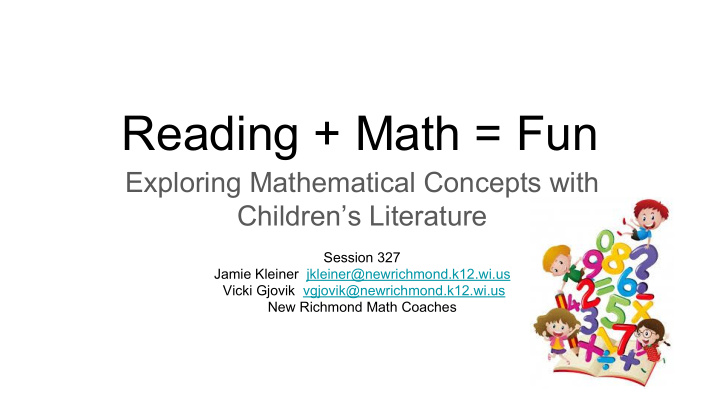



Reading + Math = Fun Exploring Mathematical Concepts with Children’s Literature Session 327 Jamie Kleiner jkleiner@newrichmond.k12.wi.us Vicki Gjovik vgjovik@newrichmond.k12.wi.us New Richmond Math Coaches
Arithmetic Arithmetic is numbers you squeeze from your head to your hand to your pencil to your paper til you get the answer. --from “Arithmetic” by Carl Sandburg
Why Should We Use Literature in Math? ● It allows all students at any achievement level to participate. ● All students can gain a deeper and more complex understanding of math.
Engagement: ● Math in the context of a story can make math more interesting, engaging and friendly. ● Math lovers have another context in which to enjoy numbers. One Guinea Pig is Not Enough by Kate Duke
Connections and Application ● Students can make connections to how they use math in the real world. ● Books can provide a real world application to emphasize that math is real and part of everyday life, not just a series of calculations. Count on Pablo by Barbara deRubertis
Math Talk and Conceptual Understanding ● The math is presented with words, not just with numbers and symbols ● Illustrations can deepen understanding ● Promotes discussion and use of vocabulary Double the Ducks by Stuart J. Murphy
Connecting Literature to the Standards
Content Standards Domains: ● Counting and Cardinality (K) ● Operations and Algebraic Thinking (includes fluency) ● Number and Operations in Base Ten ● Number and Operations-Fractions (3-5) ● Measurement and Data ● Geometry
Types of Math Books 1. Dressed-up math textbooks 2. Math within a story 3. Stories with hidden math
Dressed-up Math Textbooks (not a bad thing) ● The author’s purpose is to introduce, explain, and/or reinforce a concept. ● The book may not have a story/plot but will probably provide some context for the math. Piece=Part=Portion by Scott Gifford
Math Within A Story ● The math concept is clear. Children definitely know there is math involved. ● These books provide a context for the math. ● They may be integrated with other content areas. ● These books range from simple rhymes to more complicated plots. Full House An Invitation to Fractions by Dayle Ann Dodds
Books With Hidden Math ● These books were probably not created with math in mind but the story can lead to the exploration of a math concept. ● You might choose to read these to your class even if you weren’t going to make a math connection. ● There are more than you might think, but be careful not to force it.
Popular Book Characters On p. 75 of Harry Potter and the Sorcerer’s Stone by J.K. Rowling, Hagrid takes Harry to Gringotts to get part of his parents’ fortune so he can go shopping for school supplies. Hagrid helped Harry pile some of it into a bag. “The gold ones are Galleons,” he explained. “Seventeen silver Sickles to a Galleon and twenty-nine Knuts to a Sickle, it’s easy enough.”
Also from Harry Potter: The Hogwarts Express leaves from platform 9 ¾.
I have a book and know my purpose for using it. Now what? ● Read the book. Discuss it as you would for a literature lesson, including making predictions and connections. ● Reread any parts if you feel it is necessary or applicable. ● Make the math connection. ● Introduce the activity, game, or problem, if applicable. ● Discuss.
Other Books Used ● Ten Times Better by Richard Michelson ● Shape by Shape by Suse Macdonald ● Whole-y Cow! by Taryn Souders ● Scaredy Squirrel by Melanie Watt ● Elevator Magic by Stuart J. Murphy ● Mice Mischief by Caroline Stills ● Two of Everything by Lily Toy Hong ● Bean Thirteen by Matthew McEllicott ● I’ve Got an Elephant by Anne Ginkel ● How Big is a Foot? by Rolf Myller ● The Lion’s Share by Matthew McElligott ● Spaghetti and Meatballs for All! by Marilyn Burns ● Sea Squares by Joy N. Hulme
References Teaching Math with Picture Books, Part1 By Alycia Zimmerman (2012) www.scholastic.com/teachers/top-teaching/2012/11/teaching-math-picture-books-part-1 “3 Lessons by Marilyn Burns: Using Storybooks to Teach Math” Instructor Magazine, April 2005 http://marilynburnsmathblog.com/wordpress/ September 9, 2015 http://www.educationworld.com/a_curr/curr249.shtml Math and Literature: A Match Made in the Classroom Mastering the Basic Math Facts in Multiplication and Division by Susan O’Connell and John SanGiovanni Mastering the Basic Math Facts in Addition and Subtraction by Susan O’Connell and John SanGiovanni
Links to Book Lists http://love2learn2day.blogspot.com/p/math-book-lists-tba.html Stuartjmurphy.com http://literacy.kent.edu/Oasis/Resc/Educ/mathkidslit.html http://www.whatdowedoallday.com/math-picture-books/
I Have 10 Apples ____________ + ____________
Race to 20 Caps
Recommend
More recommend